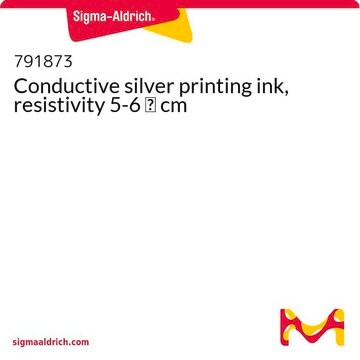736481
Silver, dispersion
nanoparticle, ≤50 nm particle size, 30-35 wt. % in triethylene glycol monoethyl ether, spec. resistivity ~ 2 μΩ-cm, for printing on ITO and glass
Synonym(s):
Silverjet DGP-45HTG, silver ink
About This Item
Recommended Products
description
surface tension 30 - 50 dyn/cm
form
nanoparticle
concentration
30-35 wt. % in triethylene glycol monoethyl ether
refractive index
n20/D 1.333
particle size
≤50 nm
viscosity
10-18 cP
density
1.45 g/mL±0.05 g/mL at 25 °C
storage temp.
2-8°C
SMILES string
[Ag]
InChI
1S/Ag
InChI key
BQCADISMDOOEFD-UHFFFAOYSA-N
Looking for similar products? Visit Product Comparison Guide
General description
Curing Temperature: Above 400 °C
Recommended substrates: ITO, Glass, Etc.
Recommended washing solvent: Polar Solvents: Ethyl Alcohol, IPA etc.
Legal Information
Signal Word
Warning
Hazard Statements
Precautionary Statements
Hazard Classifications
Aquatic Acute 1 - Aquatic Chronic 1
Storage Class Code
10 - Combustible liquids
WGK
WGK 3
Flash Point(F)
230.0 °F
Flash Point(C)
110 °C
Certificates of Analysis (COA)
Search for Certificates of Analysis (COA) by entering the products Lot/Batch Number. Lot and Batch Numbers can be found on a product’s label following the words ‘Lot’ or ‘Batch’.
Already Own This Product?
Find documentation for the products that you have recently purchased in the Document Library.
Customers Also Viewed
Articles
Inkjet printing is one of the key enabling technologies of printed electronics. Inkjet printing technology classification, aspects of materials (inks, substrates) and respective pre-and post-processing steps are discussed.
The ability to pattern conductive electrodes is technologically relevant for several applications, including photovolatics, displays, sensors, and biomedical devices.
Functional materials for printed electronics applications enable flexible displays, RFID tags, and biomedical sensors.
Progress in solution-processed functional materials leads to thin-film optoelectronic devices for industrial and consumer electronics.
Our team of scientists has experience in all areas of research including Life Science, Material Science, Chemical Synthesis, Chromatography, Analytical and many others.
Contact Technical Service













